
Pentatomidae is a family of insects belonging to the order Hemiptera, generally called shield bugs or stink bugs. Pentatomidae is the largest family in the superfamily Pentatomoidea, and contains around 900 genera and over 4700 species. As hemipterans, the pentatomids have piercing sucking mouthparts, and most are phytophagous, including several species which are severe pests on agricultural crops. However, some species, particularly in the subfamily Asopinae, are predatory and may be considered beneficial.

The Reduviidae is a large cosmopolitan family of the suborder Heteroptera of the order Hemiptera. Among the Hemiptera and together with the Nabidae almost all species are terrestrial ambush predators; most other predatory Hemiptera are aquatic. The main examples of nonpredatory Reduviidae are some blood-sucking ectoparasites in the subfamily Triatominae. Though spectacular exceptions are known, most members of the family are fairly easily recognizable; they have a relatively narrow neck, sturdy build, and a formidable curved proboscis. Large specimens should be handled with caution, if at all, because they sometimes defend themselves with a very painful stab from the proboscis.
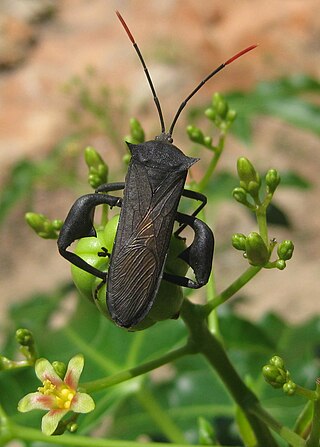
Coreidae is a large family of predominantly sap-sucking insects in the Hemipteran suborder Heteroptera. The name "Coreidae" derives from the genus Coreus, which derives from the Ancient Greek κόρις (kóris) meaning bedbug.
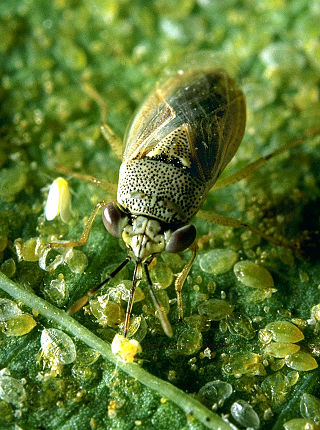
Geocoris is a genus of insects in the family Geocoridae. Commonly known as big-eyed bugs, the species in Geocoris are beneficial predators, but are often confused with the true chinch bug, which is a pest. There are more than 140 described species in Geocoris.

Belostomatidae is a family of freshwater hemipteran insects known as giant water bugs or colloquially as toe-biters, Indian toe-biters, electric-light bugs, alligator ticks, or alligator fleas. They are the largest insects in the order Hemiptera. There are about 170 species found in freshwater habitats worldwide, with more than 110 in the Neotropics, more than 20 in Africa, almost as many in the Nearctic, and far fewer elsewhere. These predators are typically encountered in freshwater ponds, marshes and slow-flowing streams. Most species are at least 2 cm (0.8 in) long, although smaller species, down to 0.9 cm (0.35 in), also exist. The largest are members of the genus Lethocerus, which can exceed 12 cm (4.5 in) and nearly reach the length of some of the largest beetles in the world. Giant water bugs are a popular food in parts of Asia.

The Lygaeidae are a family in the Hemiptera, with more than 110 genera in four subfamilies. The family is commonly referred to as seed bugs, and less commonly, milkweed bugs, or ground bugs. However, while many of the species feed on seeds, some feed on sap (mucivory) or seed pods, others are omnivores and a few, such as the wekiu bug, are carnivores that feed exclusively on insects. Insects in this family are distributed across the world. The family was vastly larger, but numerous former subfamilies have been removed and given independent family status, including the Artheneidae, Blissidae, Cryptorhamphidae, Cymidae, Geocoridae, Heterogastridae, Ninidae, Oxycarenidae and Rhyparochromidae, which together constituted well over half of the former family.

Berytidae is a family of the order Hemiptera, commonly called stilt bugs or thread bugs. Most berytids are brown to yellow, with species that are plant sap feeders, a few being predaceous. About 200 species are known from all around the world and they are classified into three subfamilies.

Insects in the subfamily Phymatinae are commonly called ambush bugs after their habit of lying in wait for prey, relying on their superb camouflage. Armed with raptorial forelegs, ambush bugs routinely capture prey ten or more times their own size. They form a subgroup within the assassin bugs.

Plagiognathus is a genus of plant bugs in the family Miridae. There are at least 110 described species in Plagiognathus.
Nemourinae is a subfamily of stoneflies in the family Nemouridae. Species of the Nemourinae have been recorded in the Nearctic, Palaearctic and Oriental realms.

Corixinae is a subfamily of aquatic bugs in the family Corixidae. There are at least 130 described species in Corixinae.

Taeniapterinae is a subfamily of flies in the family Micropezidae. There are at least 9 described species in Taeniapterinae.

Prostemmatinae is a subfamily of damsel bugs in the family Nabidae.
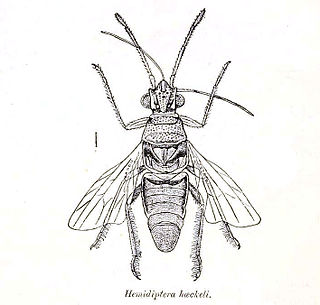
Orsillinae is a subfamily of seed bugs in the family Lygaeidae. There are at least 110 described species in Orsillinae; the type genus is Orsillus.

Cydninae is a subfamily of burrowing bugs in the family Cydnidae. There are about 11 genera and at least 40 described species in Cydninae.
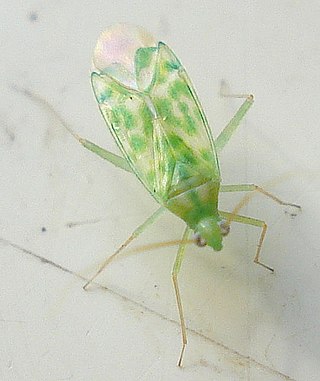
Orthotylinae is a subfamily of plant bugs in the family Miridae. There are at least 650 described species and at least 70 genera in Orthotylinae. The Orthotylinae have traditionally been diagnosed by their possession of lamellate, apically divergent parempodia.
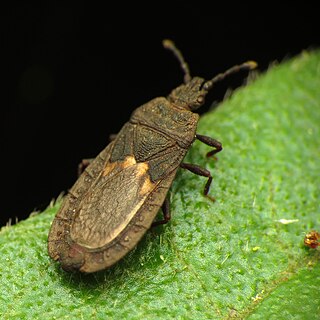
Neuroctenus is a genus of flat bugs in the Aradidae subfamily Mezirinae. There are about 7 described species in Neuroctenus.

Podopinae, known as turtle bugs, are a subfamily of the insect family Pentatomidae. The type genus is Podops.

Isometopinae is a subfamily of jumping tree bugs in the family Miridae and are the only members of the Miridae to possess ocelli. The subfamily is split into five tribes. There are 42 genera and approximately 239 described species in Isometopinae.

Aneurinae is a subfamily of flat bugs in the family Aradidae. There is at least 1 genus, Aneurus, in Aneurinae.



















